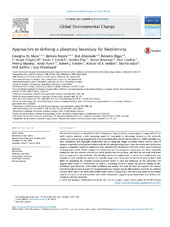| dc.contributor.author | Mace, Georgina M. | eng |
| dc.contributor.author | Reyers, Belinda | eng |
| dc.contributor.author | Alkemade, Rob | eng |
| dc.contributor.author | Biggs, Reinette | eng |
| dc.contributor.author | Chapin, F. Stuart | eng |
| dc.contributor.author | Cornell, Sarah E. | eng |
| dc.contributor.author | Díaz, Sandra | eng |
| dc.contributor.author | Jennings, Simon | eng |
| dc.contributor.author | Leadley, Paul | eng |
| dc.contributor.author | Mumby, Peter J. | eng |
| dc.contributor.author | Purvis, Andy | eng |
| dc.contributor.author | Scholes, Robert J. | eng |
| dc.contributor.author | Seddon, Alistair | eng |
| dc.contributor.author | Solan, Martin | eng |
| dc.contributor.author | Steffen, W. | eng |
| dc.contributor.author | Woodward, Guy | eng |
| dc.date.accessioned | 2015-03-06T12:40:16Z | |
| dc.date.available | 2015-03-06T12:40:16Z | |
| dc.date.issued | 2014-09 | eng |
| dc.identifier.issn | 0959-3780 | en_US |
| dc.identifier.uri | https://hdl.handle.net/1956/9480 | |
| dc.description.abstract | The idea that there is an identifiable set of boundaries, beyond which anthropogenic change will put the Earth system outside a safe operating space for humanity, is attracting interest in the scientific community and gaining support in the environmental policy world. Rockstrom et al. (2009) identify nine such boundaries and highlight biodiversity loss as being the single boundary where current rates of extinction put the Earth system furthest outside the safe operating space. Here we review the evidence to support a boundary based on extinction rates and identify weaknesses with this metric and its bearing on humanity's needs. While changes to biodiversity are of undisputed importance, we show that both extinction rate and species richness are weak metrics for this purpose, and they do not scale well from local to regional or global levels. We develop alternative approaches to determine biodiversity loss boundaries and extend our analysis to consider large-scale responses in the Earth system that could affect its suitability for complex human societies which in turn are mediated by the biosphere. We suggest three facets of biodiversity on which a boundary could be based: the genetic library of life; functional type diversity; and biome condition and extent. For each of these we explore the science needed to indicate how it might be measured and how changes would affect human societies. In addition to these three facets, we show how biodiversity's role in supporting a safe operating space for humanity may lie primarily in its interactions with other boundaries, suggesting an immediate area of focus for scientists and policymakers. | en_US |
| dc.language.iso | eng | eng |
| dc.publisher | PLoS | en_US |
| dc.rights | Attribution CC BY | eng |
| dc.rights.uri | http://creativecommons.org/licenses/by/3.0/ | eng |
| dc.subject | Biodiversity | eng |
| dc.subject | Planetary boundary | eng |
| dc.subject | Phylogenetic diversity | eng |
| dc.subject | Functional diversity | eng |
| dc.subject | Biome integrity | eng |
| dc.title | Approaches to defining a planetary boundary for biodiversity | en_US |
| dc.type | Peer reviewed | |
| dc.type | Journal article | |
| dc.date.updated | 2015-03-05T10:49:08Z | |
| dc.description.version | publishedVersion | en_US |
| dc.rights.holder | Copyright 2014 The Authors | en_US |
| dc.identifier.doi | https://doi.org/10.1016/j.gloenvcha.2014.07.009 | |
| dc.identifier.cristin | 1194543 | |
| dc.source.journal | Global Environmental Change | |
| dc.source.40 | 28 | |
| dc.source.pagenumber | 289-297 | |

